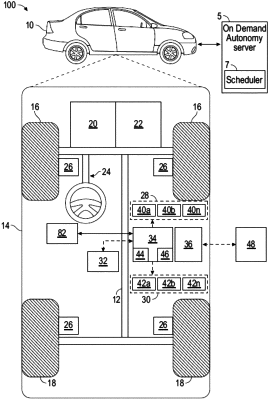| CPC G06Q 10/02 (2013.01) [G06Q 50/30 (2013.01); G07C 5/0808 (2013.01)] | 18 Claims |

|
1. A cloud-based server system configured for an On-Demand Autonomy (ODA) service, comprising:
a cloud-based server in communication with a first vehicle and at least one second vehicle and comprising a scheduler configured to by a processor receive a trip request for the ODA service from the first vehicle, and seek an agreement to establish a virtual link with the first vehicle to the at least one second vehicle by identifying the at least one second vehicle from a group of second vehicles, wherein the scheduler is further configured to:
broadcast the trip request to the group of second vehicles:
receive a set of responses submitted by a subset of the group of second vehicles to the broadcast trip request;
identify the at least one second vehicle from submitted responses from the subset of the group of second vehicles based on an application using a modeled clone with a set of functionalities to perform a matching operation between the first vehicle with the at least one second vehicle from the group of second vehicles; and
coordinate one or more responses between the first vehicle and the at least one second vehicle based on results of the matching operation to confirm an acceptance of the agreement;
in response to confirmation of the acceptance of the agreement, the cloud-based server configured to create a trip plan for the trip request for the ODA service based on a set of preferences received from the first vehicle and the at least one second vehicle; and
present, by a heartbeat display, to each vehicle that dynamically presents real-time movement corresponding to monitored data that is transmitted back and forth between each vehicle that continuously monitors a set of health parameters associated with each vehicle, wherein the heartbeat display comprises a window that is indicative of a range of a vehicle status being inactive in the virtual link, degraded in the virtual link, and active in the virtual link.
|